Kerala.com Travel Division is approved as an Inbound Tour Operator by the Ministry of Tourism, Govt of India and the Department of Tourism, Government of Kerala
 Japanese gardens are very important to the Japanese. All of the gardens are representations of nature. The purpose of these gardens is to capture nature in the utmost natural way, and add to it a touch of artistic feeling. The Japanese gardens, for the Japanese people, have an ancient history influenced by Shinto, Buddhist and Taoist philosophies. These philosphies are used in the creation of the Japanese Gardens so as to bring a spiritual sense to the gardens. The Buddhist influence makes the garden a quiet place, allowing people to look back and reflect upon themselves, or meditate.
Japanese gardens are very important to the Japanese. All of the gardens are representations of nature. The purpose of these gardens is to capture nature in the utmost natural way, and add to it a touch of artistic feeling. The Japanese gardens, for the Japanese people, have an ancient history influenced by Shinto, Buddhist and Taoist philosophies. These philosphies are used in the creation of the Japanese Gardens so as to bring a spiritual sense to the gardens. The Buddhist influence makes the garden a quiet place, allowing people to look back and reflect upon themselves, or meditate.
The essential elements to a Japanese garden--water, garden plants, stones, waterfalls, trees, and bridges--creates this symbolism.
There are two common misconceptions concerning Japanese gardens.
The first is that the Japanese gardens always follow certain ground rules with regard to both arrangement and content. This is not true. The architect does follow some rules, but he/she is free to express his/her creativity through the Japanese garden.
The second is that Japanese gardens are miniature gardens. This is also not true. Everything that is designed is accessible for full size adults, but sometimes the small trees give the illusion of the Japanese garden being small.
There are five different styles of Japanese gardens.
- Strolling Garden
- Natural Garden
- Sand & Stone Garden
- Tea Garden
- The Flat Garden
Strolling Garden
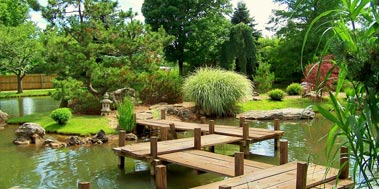 The Strolling Pond Garden, while also being the largest, is considered the best garden due to its many pleasing views from various locations in the garden. This garden has many different things to make up. It has a water fall with a moonbridge spanning a pond. It may seem that it is just filled with water and rocks. But if you stop and listen you can hear the soothing sound of the moving water. This garden contains much symbolism. In this garden there are two rocks; one is a tortoise and the other is a crane representing long life and good health respectively.
The Strolling Pond Garden, while also being the largest, is considered the best garden due to its many pleasing views from various locations in the garden. This garden has many different things to make up. It has a water fall with a moonbridge spanning a pond. It may seem that it is just filled with water and rocks. But if you stop and listen you can hear the soothing sound of the moving water. This garden contains much symbolism. In this garden there are two rocks; one is a tortoise and the other is a crane representing long life and good health respectively.
Natural Garden
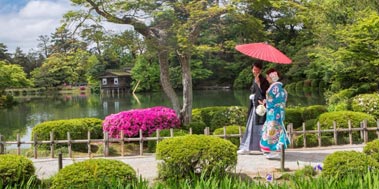 The Natural Garden is given in its name itself because rodents and the birds live there, and they are constantly reconstucting it by tearing apart the moss. It has a cascading waterfall and pond. In this garden is a sheltered building called the "Azumaya," which is like a gazebo. This garden can not get anymore natural than it already is. The garden is set up in a artistic way but once nature hits it, the garden just becomes part of nature on its own.
The Natural Garden is given in its name itself because rodents and the birds live there, and they are constantly reconstucting it by tearing apart the moss. It has a cascading waterfall and pond. In this garden is a sheltered building called the "Azumaya," which is like a gazebo. This garden can not get anymore natural than it already is. The garden is set up in a artistic way but once nature hits it, the garden just becomes part of nature on its own.
Sand&Stone Garden
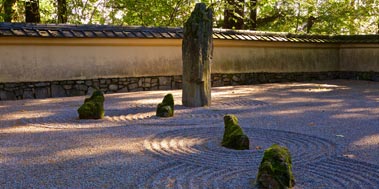 Sand and Stone Garden was developed in the Muromachi Era and represents Zen spiritualism. It is primarily used as a place for monks to meditate. The garden is surrounded by a beautiful wall. Sand and stone make up this type of garden, hence the name. It is rectangular with carefully raked white sand that is enclosed by a beautiful tile-roofed plaster wall. There are five groupings of fifteen stones arranged in clusters of two, three, and five. At the base of each grouping is growing moss. White sand is used with rocks arranged in a simple, but artistic, manner. When a person looks at this garden it looks "void." The sand gives off the sense of space and emptiness. The key here is that the sand clears the visitors' minds of the outside world, allowing them to make their own interpretations of the garden. Some say that the white sand represents a body of water, and the rocks in the middle of the sand are the islands of Japan. The rocks are set up in an artistic arrangement. If the artist was to add another rock, it would make a difference with relation to the garden. If you were to add a rock, or move one, it would destroy the composition of the garden--and possibly the meaning as well. This shows that the Sand and Stone Garden is a delicate artistic representation built with great artistic talent and a high level of spiritual involvement.
Sand and Stone Garden was developed in the Muromachi Era and represents Zen spiritualism. It is primarily used as a place for monks to meditate. The garden is surrounded by a beautiful wall. Sand and stone make up this type of garden, hence the name. It is rectangular with carefully raked white sand that is enclosed by a beautiful tile-roofed plaster wall. There are five groupings of fifteen stones arranged in clusters of two, three, and five. At the base of each grouping is growing moss. White sand is used with rocks arranged in a simple, but artistic, manner. When a person looks at this garden it looks "void." The sand gives off the sense of space and emptiness. The key here is that the sand clears the visitors' minds of the outside world, allowing them to make their own interpretations of the garden. Some say that the white sand represents a body of water, and the rocks in the middle of the sand are the islands of Japan. The rocks are set up in an artistic arrangement. If the artist was to add another rock, it would make a difference with relation to the garden. If you were to add a rock, or move one, it would destroy the composition of the garden--and possibly the meaning as well. This shows that the Sand and Stone Garden is a delicate artistic representation built with great artistic talent and a high level of spiritual involvement.
Tea Garden
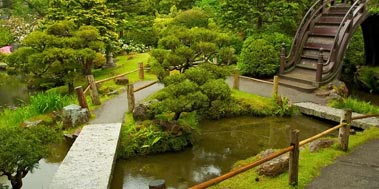 The Tea Garden has two sections: an outer garden and an inner garden. There is also a ceremonial Tea house. Everything that is included in this garden is placed with the utmost authentic care for arrangement. The stones, stone lanterns, and the traditional stone water basin all have a symbolic relationship.
The Tea Garden has two sections: an outer garden and an inner garden. There is also a ceremonial Tea house. Everything that is included in this garden is placed with the utmost authentic care for arrangement. The stones, stone lanterns, and the traditional stone water basin all have a symbolic relationship.
The inner garden is a private garden and is to be viewed only from the Tea House. This garden surrounds the Tea house. The outer garden (soto roji) is the waiting area for guests. The guests wait here, on a wooden bench with straw cushions, for their host to come and greet them. When the weather is cold, a teaburi, a kind of heater is used to keep guests warm. There is also a wooden pail of hot water set out for guests to wash their hands and rinse their mouths as a sign of ritual purification before entering to Tea House.
The Flat Garden
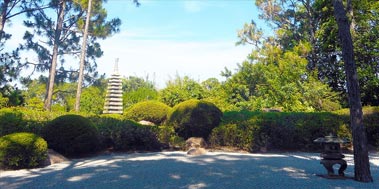 The Natural Garden is given its name because rodents and the birds live there, and they are constantly reconstucting it by tearing apart the moss. It has a cascading waterfall and pond. In this garden is a sheltered building called the "Azumaya," which is like a gazebo. This garden can not get anymore natural than it already is. The garden is set up in an artistic way but once nature hits it, the garden just becomes part of nature on its own.
The Natural Garden is given its name because rodents and the birds live there, and they are constantly reconstucting it by tearing apart the moss. It has a cascading waterfall and pond. In this garden is a sheltered building called the "Azumaya," which is like a gazebo. This garden can not get anymore natural than it already is. The garden is set up in an artistic way but once nature hits it, the garden just becomes part of nature on its own.
